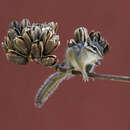en
names in breadcrumbs


This taxon is found in the Sierra Madre Oriental pine-oak forests, which exhibit a very diverse community of endemic and specialized species of plants, mammals, reptiles and amphibians. These high mountains run north to south, beginning in the USA and ending in Mexico. The Sierra Madre Oriental pine-oak forests are a highly disjunctive ecoregion, owing to the fact that they are present only at higher elevations, within a region with considerable expanses of lower elevation desert floor.
The climate is temperate humid on the northeastern slope, and temperate sub-humid on the western slope and highest portions of the mountain range. Pine-oak forest habitat covers most of the region, even though most of the primary forest has been destroyed or degraded. However, the wettest portions house a community of cloud forests that constitute the northernmost patches of this vegetation in Mexico. The forests grow on soils derived from volcanic rocks that have a high content of organic matter. The soils of lower elevations are derived from sedimentary rocks, and some of them are formed purely of limestone. In the northernmost portions of the ecoregion, the forests occur on irregular hummocks that constitute biological "islands" of temperate forest in the middle of the Chihuahuan Desert. To the south, from Nuevo León southward until Guanajuato and Queretaro, the ecoregion is more continuous along the mainstem of the Sierra Madre Oriental.
Dominant tree species include the pines: the endemic Nelson's Pine (Pinus nelsonii), Mexican Pinyon (P. cembroides), Smooth-bark Mexican Pine (P. pseudostrobus), and Arizona Pine (P. arizonica); and the oaks Quercus castanea and Q. affinis. In mesic environments, the most common species are P. cembroides, and Alligator Juniper (Juniperus deppeana), but in more xeric environments on the west slopes of the mountains, the endemic P. pinceana is more abundant. Gregg's Pine (P. greggii) and Jelecote Pine (P. patula) are endemic.
Many mammalian species wander these rugged hills. Mule Deer (Odocoileus hemionus), Puma (Puma concolor), Cliff Chipmunk (Tamias dorsalis), Collared Peccary (Tayassu tajacu), Coati (Nasua narica), Jaguar (Panthera onca) and Coyote (Canis latrans) are a few of the many diverse mammals that inhabit this ecoregion. Some threatened mammals found in the ecoregion are: Bolaños Woodrat (Neotoma palatina VU); Diminutive Woodrat (Nelsonia neotomodon NT), known chiefly from the western versant of the Sierra Madre; Chihuahuan Mouse (Peromyscus polius NT); and Mexican Long-nosed Bat (Leptonycteris nivalis EN).
A considerable number of reptilian taxa are found in the Sierra Madre Oriental pine-oak forests, including three endemic snakes: Ridgenose Rattlesnake (Crotalus willardi); Fox´s Mountain Meadow Snake (Adelophis foxi); and the Longtail Rattlesnake (Crotalus stejnegeri VU), restricted to the central Sierra Madre. An endemic skink occurring in the ecoregion is the Fair-headed Skink (Plestiodon callicephalus). The Striped Plateau Lizard (Sceloporus virgatus) is endemic to the ecoregion. The Sonoran Mud Turtle (Kinosternon sonoriense VU) is found in the ecoregion and ranges from southwestern New Mexico south to northwestern Chihuahua.
The following anuran taxa occur in the Sierra Madre Oriental pine-oak forests: Red-spotted Toad (Anaxyrus punctatus); Cane Toad (Rhinella marina); Elegant Narrow-mouthed Toad (Gastrophryne elegans); New Mexico Spadefoot Toad (Spea multiplicata); Sinaloa Toad (Incilius mazatlanensis); Pine Toad (Incilius occidentalis); Southwestern Toad (Anaxyrus microscaphus); Woodhouse's Toad (Anaxyrus woodhousii); Great Plains Narrowmouth Toad (Gastrophryne olivacea); Great Plains Toad (Anaxyrus cognatus); Plateau Toad (Anaxyrus compactilis); Texas Toad (Anaxyrus speciosus); Sonoran Desert Toad (Incilius alvarius), found only at lower ecoregion elevations here; Rana-ladrona Silbadora (Eleutherodactylus teretistes); Sabinal Frog (Leptodactylus melanonotus); Mexican Leaf Frog (Pachymedusa dacnicolor); Montezuma Leopard Frog (Lithobates montezumae); Yavapai Leopard Frog (Lithobates yavapaiensis); Northwest Mexico Leopard Frog (Lithobates magnaocularis); Bigfoot Leopard Frog (Lithobates megapoda), who generally breeds in permanent surface water bodies; Mexican Cascade Frog (Lithobates pustulosus); Tarahumara Frog (Lithobates tarahumarae VU); Western Barking Frog (Craugastor augusti); Lowland Burrowing Frog (Smilisca fodiens); Taylor's Barking Frog (Craugastor occidentalis); Blunt-toed Chirping Frog (Eleutherodactylus modestus VU), found only at the very lowest elevations of the ecoregion; Shiny Peeping Frog (Eleutherodactylus nitidus); California Chorus Frog (Pseudacris cadaverina); Rio Grande Frog (Lithobates berlandieri); Madrean Treefrog (Hyla eximia); Mexican Treefrog (Smilisca baudinii); Dwarf Mexican Treefrog (Tlalocohyla smithii); Canyon Treefrog (Hyla arenicolor); Northern Sheep Frog (Hypopachus variolosus); Chiricahua Leopard Frog (Lithobates chiricahuensis). There are three salamanders found in the ecoregion: the endemic Sacramento Mountains Salamander (Aneides hardii), found only in very high montane reaches above 2400 meters; Tiger Salamander (Ambystoma tigrinum); and the Tarahumara Salamander (Ambystoma rosaceum).